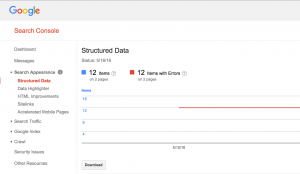Web presence is a huge part of running a successful business. People no longer use a phone book to find businesses; instead they do a simple Google search. Ensuring your company ranks high on search engines can turn a moderate success into an astounding one. If you’ve come to our website, chances are you already know this, and are ready to make your mark on the web. A step in the right direction to a strong web presence is Google’s Search Console (most commonly known as Google Webmaster Tools).
Google Search Console is one of the free toolsets provided by Google to monitor a website’s performance. It offers data that is critical for search engine optimization, or the techniques marketing companies use to increase their search engine results page rank (SERP). The service provides analytical information, including website traffic, link quality, malware or adware warnings, how users are finding your website, keyword strings, and so much more. It also offers the ability to inform Google of new pages to index, and the ability to disavow negative or questionable links.
It might seem like a lot to follow, but using Search Console is crucial. In order to effectively manage a website, at the very minimum you need to know the amount of traffic you receive per day, and when you receive that traffic.
Here’s an example. You own a small business selling sailboat paraphernalia in coastal Connecticut. Your web page receives some views, but most of your web traffic is driven by word of mouth…the business is completely void of SEO. Using Webmaster Tools, you’ll first want to submit a sitemap, which tells Google about the content, taxonomy, and structure of your site. This gives the search engine the opportunity to index every page that you have published. If Google hasn’t indexed your pages, you won’t show up in Google search results, effectively negating the benefits of having a website.
Next you’ll want to view how your traffic is generated. Are people typing in your URL to access your website directly? Are they clicking a link that they found on another site? Did the link originate from Google search results, and if so, what keywords led to your website appearing? Knowing where your traffic comes from is key to increasing it. In our example, your business can cover a large area due to New England’s small size and common culture. If Google Webmaster Tools shows traffic directing to your page from say, keywords associated with Massachusetts, then it may help your sales to target customers in Massachusetts, specifically.
Moving deeper into Google’s data, our example business can look at inbound links and their origins. Google’s algorithm takes into account other websites that link in to your pages when determining search rankings. Also accounted for are outbound links you post, although they aren’t valued as much. Search Console will help you determine if the pages linking to you are reputable and within your niche, and are therefore increasing traffic, or if they’re unrelated and hurting page rank. Inbound links from another New England sailing company would be valuable, but inbound links from, say, DoctorOz.com would not. Webmaster tools allow users to disavow unrelated links, saving valuable pagerank.
Also available is a website’s click-through rate, or the percentage of people that are clicking on the site in search results. This could be useful in determining if your meta description, or the short description that appears under the link in a Google search, is drawing users to click on your link. As one of the first things users see before choosing a link to follow, it’s important to create a quality meta description.
The amount of data Google Webmaster Tools provides goes deeper still, but these basics should help you get an idea of why we recommend it so highly. If you’re thinking about diving into search engine optimization but don’t know where to start, give us a call. Our web presence specialists will be happy to help.

